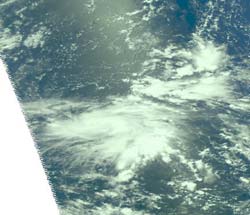NASA Tracks Tiny Tropical Storm Guchol in Western North Pacific

NASA's Aqua satellite passed over Tropical Storm Guchol on June 12 at 0335 UTC and captured a near-infrared image of the storm from the Atmospheric Infrared Sounder (AIRS) instrument. The infrared imagery indicates that convection and thunderstorms are consolidating over the low-level circulation center. Two tightly curved bands of thunderstorms are wrapping into the low-level center from the northeastern and southwestern quadrants of the storm.<br>Credit: NASA/JPL, Ed Olsen <br>
NASA's Aqua satellite passed over Tropical Storm Guchol on June 12 at 0335 UTC and captured a near-infrared image of the storm from the Atmospheric Infrared Sounder (AIRS) instrument. The infrared imagery indicates that convection (rising air that forms thunderstorms) and thunderstorms are consolidating over the low-level circulation center.
Two tightly curved bands of thunderstorms are wrapping into the low-level center from the northeastern and southwestern quadrants of the storm. Satellite imagery indicates that dry air along the northern edge of the storm is preventing thunderstorm formation, which accounts for the slow development of the storm, and the smaller size.
On June 12 at 1500 UTC (11 a.m. EDT/U.S.), Guchol, formerly known as Tropical Depression 05W, has maximum sustained winds near 65 knots (~75 mph/120.4 kph). It is located about 225 nautical miles east of Yap, near 9.7 North and 141.7 East. It is moving to the west at 7 knots (8 mph/13 kph). A tropical storm warning is in effect for Fais and Ulithi in Yap State, Micronesia.
Text Credit: Rob Gutro
NASA Goddard Space Flight Center, Greenbelt, Md.
Media Contact
All latest news from the category: Earth Sciences
Earth Sciences (also referred to as Geosciences), which deals with basic issues surrounding our planet, plays a vital role in the area of energy and raw materials supply.
Earth Sciences comprises subjects such as geology, geography, geological informatics, paleontology, mineralogy, petrography, crystallography, geophysics, geodesy, glaciology, cartography, photogrammetry, meteorology and seismology, early-warning systems, earthquake research and polar research.
Newest articles

Machine learning algorithm reveals long-theorized glass phase in crystal
Scientists have found evidence of an elusive, glassy phase of matter that emerges when a crystal’s perfect internal pattern is disrupted. X-ray technology and machine learning converge to shed light…

Mapping plant functional diversity from space
HKU ecologists revolutionize ecosystem monitoring with novel field-satellite integration. An international team of researchers, led by Professor Jin WU from the School of Biological Sciences at The University of Hong…

Inverters with constant full load capability
…enable an increase in the performance of electric drives. Overheating components significantly limit the performance of drivetrains in electric vehicles. Inverters in particular are subject to a high thermal load,…





















